Mechanical Fault Diagnosis of HVCBs Based on Multi-Feature Entropy Fusion and Hybrid Classifier
Abstract
1. Introduction
2. Variational Mode Decomposition
- (1)
- Hilbert transform is performed on each IMF to get its analytical signal.
- (2)
- Estimate the center frequency ωk of each IMF and mix them by frequency shifting, which can transform the frequency spectrum of each IMF to the baseband.
- (3)
- The bandwidth of each IMF is estimated through the squared L2-norm of a gradient. Consequently, the construction of the constrained variational problem can be described by Equation (3).where and are shorthand notations for the set of all IMFs and their center frequencies.
- (4)
- Due to the difficulty of solving the constrained problem, the penalty parameter and the Lagrange multiplier are introduced to transform Equation (3) into an unconstrained variational problem, thereby obtaining an augmented Lagrange expression:
3. Feature Extraction
3.1. Multi-Feature Entropy
3.1.1. Envelope Energy Entropy
3.1.2. Envelope Spectrum Entropy
3.1.3. Multi-Resolution Singular Spectrum Entropy
3.2. Principle Component Analysis
4. Hybrid Classifier
4.1. Principles of SVM
4.2. Principles of SVDD
4.3. Fault Diagnosis Process
- (1)
- Decompose the vibration signal into K IMFs by VMD.
- (2)
- Calculate EEE, ESE, and MSSE of signals according to Equations (11)–(18) to form the multi-feature entropy vector.
- (3)
- Use PCA to reduce the dimension of the multi-feature entropy vectors.
- (4)
- Use SVDD to diagnosis whether unknown faults occur in HVCBs by solving Equation (29). If f(x) > 0, the sample is imported into the area of known faults; otherwise, it is imported into the area of unknown faults.
- (5)
- Use SVM to classify the fault type in known states area.
5. Experimental Application
5.1. Data Acquisition
5.2. Signal Processing
5.3. Feature Extraction
5.3.1. Multi-Feature Entropy Extraction
5.3.2. Multi-Feature Entropy Fusion
5.4. Fault Classification Using the Hybrid Classifier
5.4.1. Unknown Fault Detection
5.4.2. Known States Recognition and Classification
6. Conclusions
- (1)
- The fault signatures can be extracted precisely by using the VMD-MFEF method. Compared with the EMD-MFEF feature vectors, the VMD-MFEF feature vectors have better spatial distribution in the feature space. Different states are completely separated from each other in feature space.
- (2)
- To test the stability of SVDD, the three faults simulated in this paper are assumed to be unknown faults. The detection accuracies of the unknown fault in the three cases are 100%, 87.5%, and 100% respectively. The reason for the low detection accuracy in the second case is that the spatial positions of Faults I and II are close in the feature space, which indicates that the fault characteristics between them are similar. Although the two faults can be correctly classified in the classification of known states when both of them are involved in the training of SVM, the maintenance personnel should pay attention to the similarity between the two faults’ characteristics to avoid the occurrence of error diagnosis. Compared with SVM and OCSVM, SVDD has a distinct advantage in the detection of unknown faults of HVCBs.
- (3)
- Compared with the single feature extraction method, the proposed MFEF method is superior in terms of feature extraction. The experimental results of the classification of known states show that the faults classification accuracy of the MFEF method achieves an accuracy of 100%, while the single-feature method only achieved an accuracy of 75%.
Author Contributions
Acknowledgments
Conflicts of Interest
References
- Janssen, A.; Makareinis, D.; Solver, C.E. International Surveys on Circuit-Breaker Reliability Data for Substation and System Studies. IEEE Trans. Power Deliv. 2014, 29, 808–814. [Google Scholar] [CrossRef]
- Heising, C.R.; Janssen, A.L.J.; Lanz, W.; Colombo, E.; Dialynas, E.N. Summary of CIGRE 13.06 Working Group world wide reliability data and maintenance cost data on high voltage circuit breakers above 63 kV. In Proceedings of the 1994 IEEE Industry Application Society Annual Meeting, Denver, CO, USA, 2–6 October 1994. [Google Scholar]
- Polycarpou, A.A.; Soom, A.; Swarnakar, V.; Valtin, R.A.; Acharya, R.S.; Demjanenko, V.; Soumekh, M.; Benenson, D.M.; Porter, J.W. Event timing and shape analysis of vibration bursts from power circuit breakers. IEEE Trans. Power Deliv. 1996, 11, 848–857. [Google Scholar] [CrossRef]
- Runde, M.; Aurud, T.; Lundgaard, L.E.; Ottesen, G.E.; Faugstad, K. Acoustic diagnosis of high voltage circuit-breakers. IEEE Trans. Power Deliv. 1992, 7, 1306–1315. [Google Scholar] [CrossRef]
- CIGRE Working Group. Final Report of the Second International Enquiry on High Voltage Circuit Breaker Failures and Defects in Service; CIGRE Report No. 83; CIGRE: Paris, France, 1994. [Google Scholar]
- Landry, M.; Leonard, F.; Landry, C.; Beauchemin, R.; Turcotte, O.; Brikci, F. An improved vibration analysis algorithm as a diagnostic tool for detecting mechanical anomalies on power circuit breakers. IEEE Trans. Power Deliv. 2008, 23, 1986–1994. [Google Scholar] [CrossRef]
- Huang, J.; Hu, X.; Geng, X. An intelligent fault diagnosis method of high voltage circuit breaker based on improved EMD energy entropy and multi-class support vector machine. Electr. Power Syst. Res. 2011, 81, 400–407. [Google Scholar] [CrossRef]
- Huang, J.; Hu, X.; Yang, F. Support vector machine with genetic algorithm for machinery fault diagnosis of high voltage circuit breaker. Measurement 2011, 44, 1018–1027. [Google Scholar] [CrossRef]
- Meng, Y.P.; Jia, S.L.; Shi, Z.Q.; Rong, M.Z. The detection of the closing moments of a vacuum circuit breaker by vibration analysis. IEEE Trans. Power Deliv. 2006, 21, 652–658. [Google Scholar] [CrossRef]
- Li, B.; Liu, M.; Guo, Z.; Ji, Y. Mechanical Fault Diagnosis of High Voltage Circuit Breakers Utilizing EWT-Improved Time Frequency Entropy and Optimal GRNN Classifier. Entropy 2018, 20, 448. [Google Scholar] [CrossRef]
- Fei, M.; Yi, P.; Zhu, K.; Zheng, J. On-line hybrid fault diagnosis method for high voltage circuit breaker. J. Intell. Fuzzy Syst. 2017, 33, 2763–2774. [Google Scholar] [CrossRef]
- Zhu, K.; Mei, F.; Zheng, J. Adaptive fault diagnosis of HVCBs based on P-SVDD and P-KFCM. Neurocomputing 2017, 240, 127–136. [Google Scholar] [CrossRef]
- Meng, F.; Wu, S.; Zhang, F.; Liang, L. Numerical Modeling and Experimental Verification for High-Speed and Heavy-Load Planar Mechanism with Multiple Clearances. Math. Probl. Eng. 2015, 2015, 1–15. [Google Scholar] [CrossRef]
- Niu, W.; Liang, G.; Yuan, H.; Li, B. A Fault Diagnosis Method of High Voltage Circuit Breaker Based on Moving Contact Motion Trajectory and ELM. Math. Probl. Eng. 2016, 2016, 1–10. [Google Scholar] [CrossRef]
- Runde, M.; Ottesen, G.E.; Skyberg, B.; Ohlen, M. Vibration analysis for diagnostic testing of circuit-breakers. IEEE Trans. Power Deliv. 1996, 11, 1816–1823. [Google Scholar] [CrossRef]
- Huang, N.; Chen, H.; Cai, G.; Fang, L.; Wang, Y. Mechanical Fault Diagnosis of High Voltage Circuit Breakers Based on Variational Mode Decomposition and Multi-Layer Classifier. Sensors 2016, 16, 1887. [Google Scholar] [CrossRef] [PubMed]
- Ma, S.; Chen, M.; Wu, J.; Wang, Y.; Jia, B.; Jiang, Y. Intelligent Fault Diagnosis of HVCB with Feature Space Optimization-Based Random Forest. Sensors 2018, 18, 1221. [Google Scholar] [CrossRef] [PubMed]
- Liu, M.; Wang, K.; Sun, L.; Zhen, J. Applying empirical mode decomposition (EMD) and entropy to diagnose circuit breaker faults. Optik-Int. J. Light Electron Opt. 2015, 126, 2338–2342. [Google Scholar]
- Huang, N.; Fang, L.; Cai, G.; Xu, D.; Chen, H.; Nie, Y. Mechanical Fault Diagnosis of High Voltage Circuit Breakers with Unknown Fault Type Using Hybrid Classifier Based on LMD and Time Segmentation Energy Entropy. Entropy 2016, 18, 322. [Google Scholar] [CrossRef]
- Dragomiretskiy, K.; Zosso, D. Variational Mode Decomposition. IEEE Trans. Signal Process. 2014, 62, 531–544. [Google Scholar] [CrossRef]
- Fei, C.W.; Choy, Y.S.; Bai, G.C.; Tang, W.Z. Multi-feature entropy distance approach with vibration and acoustic emission signals for process feature recognition of rolling element bearing faults. Struct. Health Monit. 2017, 17, 156–168. [Google Scholar] [CrossRef]
- Sun, S.G.; Ding, M.Z.; Tian, P.; Wang, J.X. Feature extraction of IGBT open circuit fault in active power filter based on multi-feature fusion. Chin. J. Sci. Instrum. 2017, 12, 2888–2899. (In Chinese) [Google Scholar]
- Glowacz, A.; Glowacz, Z. Diagnosis of the three-phase induction motor using thermal imaging. Infrared Phys. Technol. 2016, 81, 7–16. [Google Scholar] [CrossRef]
- Li, Y.; Li, G.; Yang, Y.; Liang, X.; Xu, M. A fault diagnosis scheme for planetary gearboxes using adaptive multi-scale morphology filter and modified hierarchical permutation entropy. Mech. Syst. Signal Process. 2018, 105, 319–337. [Google Scholar] [CrossRef]
- Glowacz, A. Recognition of acoustic signals of induction motor using FFT, SMOFS-10 and LSVM. Maint. Reliab. 2015, 17, 569–574. [Google Scholar] [CrossRef]
- Laib dit Leksir, Y.; Mansour, M.; Moussaoui, A. Localization of thermal anomalies in electrical equipment using Infrared Thermography and support vector machine. Infrared Phys. Technol. 2018, 89, 120–128. [Google Scholar] [CrossRef]
- Zhang, Y.; Wang, P.; Ni, T.; Cheng, P.; Lei, S. Wind power prediction based on LS-SVM model with error correction. Adv. Electr. Comput. Eng. 2017, 17, 3–8. [Google Scholar] [CrossRef]
- Wilk-Kolodziejczyk, D.; Regulski, K.; Gumienny, G. Comparative analysis of the properties of the nodular cast iron with carbides and the austempered ductile iron with use of the machine learning and the support vector machine. Int. J. Adv. Manuf. Technol. 2016, 87, 1077–1093. [Google Scholar] [CrossRef]
- Tax, D.M.J.; Duin, R.P.W. Support vector data description. Mach. Learn. 2004, 54, 45–66. [Google Scholar] [CrossRef]
- Shannon, C.E. A mathematical theory of communication. Bell Syst. Tech. J. 1948, 27, 379–423. [Google Scholar] [CrossRef]
- Kong, X.; Xu, X.; Yan, Z.; Chen, S.; Yang, H.; Han, D. Deep learning hybrid method for islanding detection in distributed generation. Appl. Energy 2018, 210, 776–785. [Google Scholar] [CrossRef]
- Wold, S.; Esbensen, K.; Geladi, P. Principal component analysis. Chemom. Intell. Lab. Syst. 1987, 2, 37–52. [Google Scholar] [CrossRef]
- Zhou, J.; Fu, W.; Zhang, Y.; Xiao, H.; Xiao, J.; Zhang, C. Fault diagnosis based on a novel weighted support vector data description with fuzzy adaptive threshold decision. Trans. Inst. Meas. Control 2016, 40, 71–79. [Google Scholar] [CrossRef]
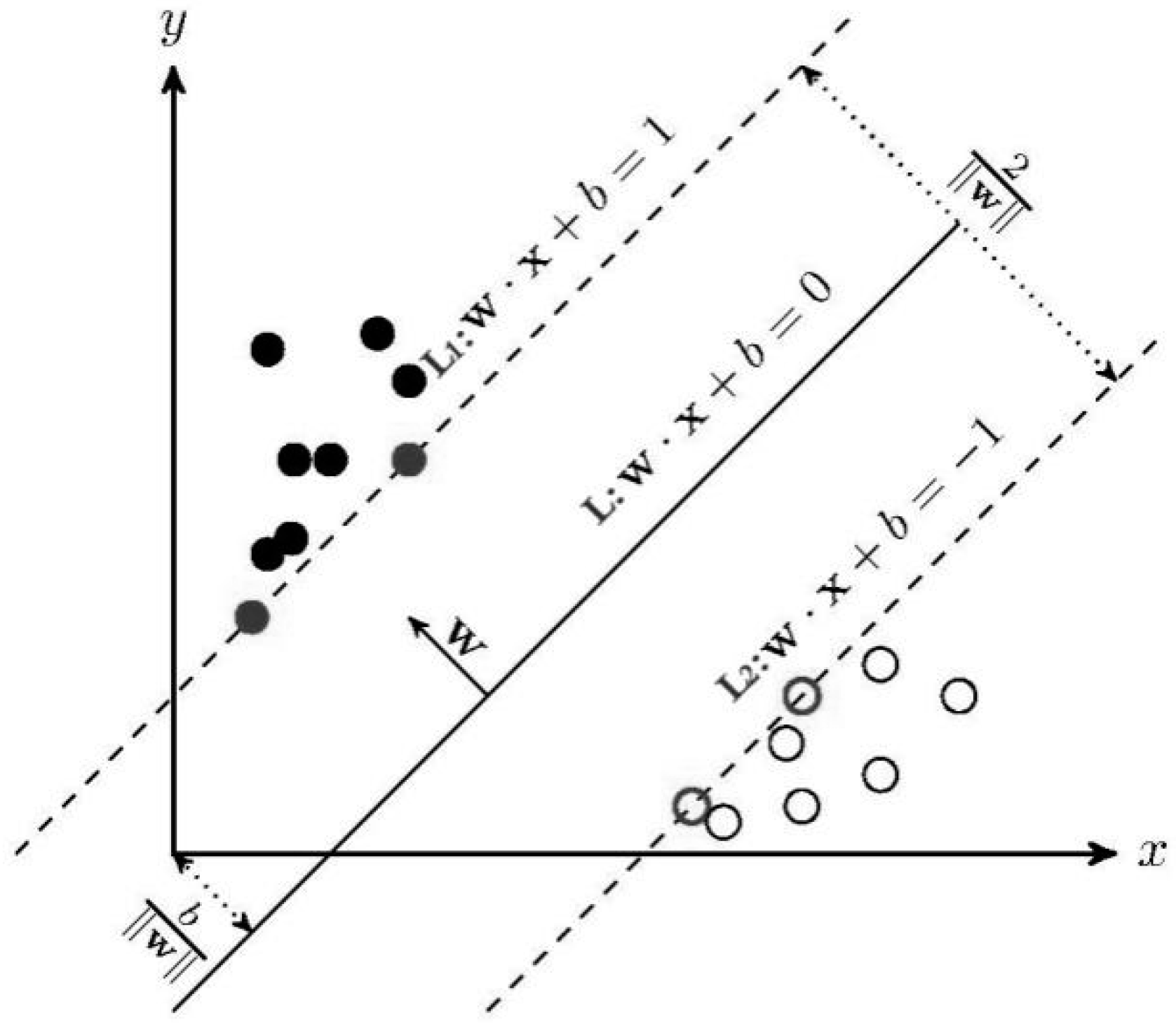
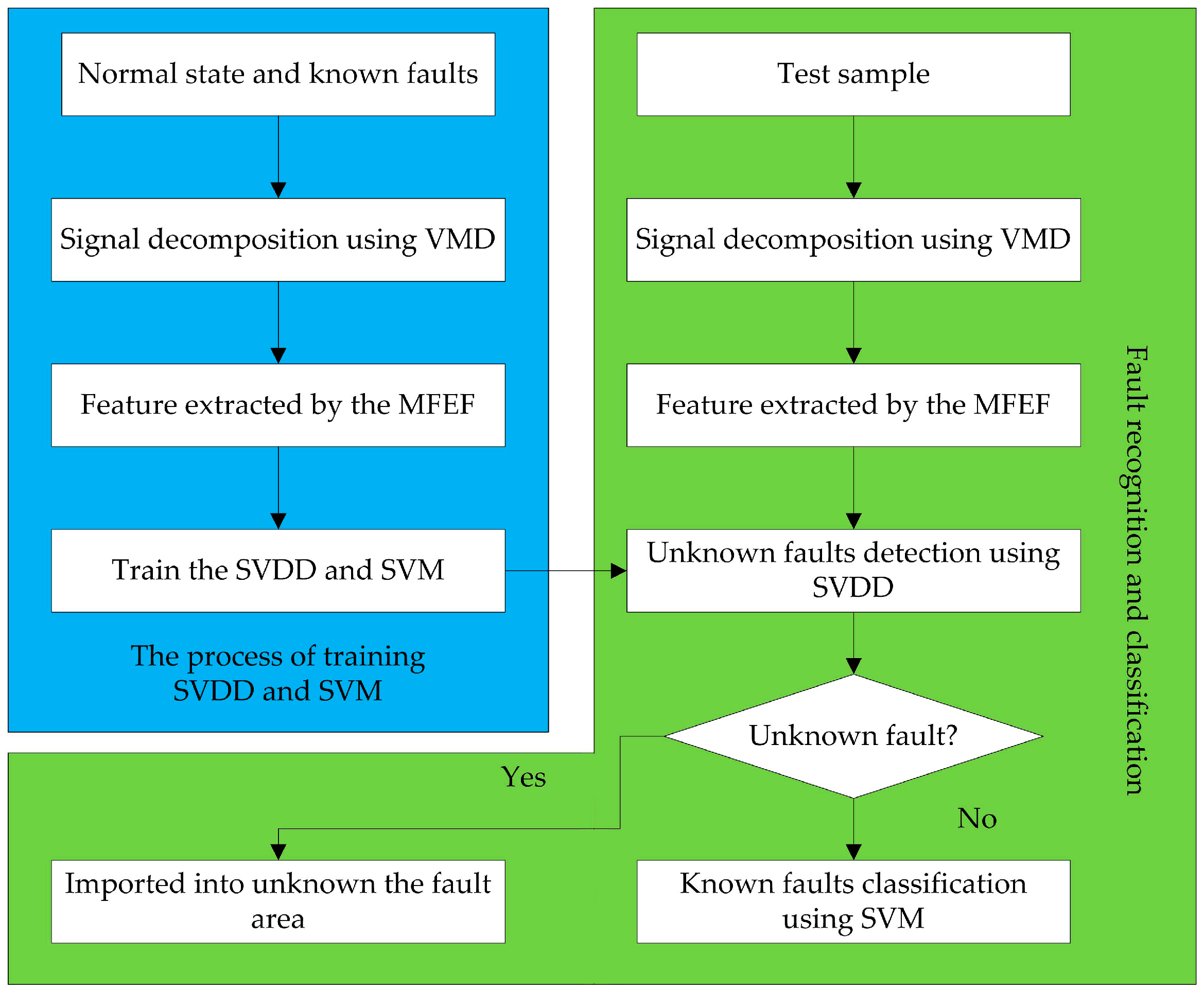
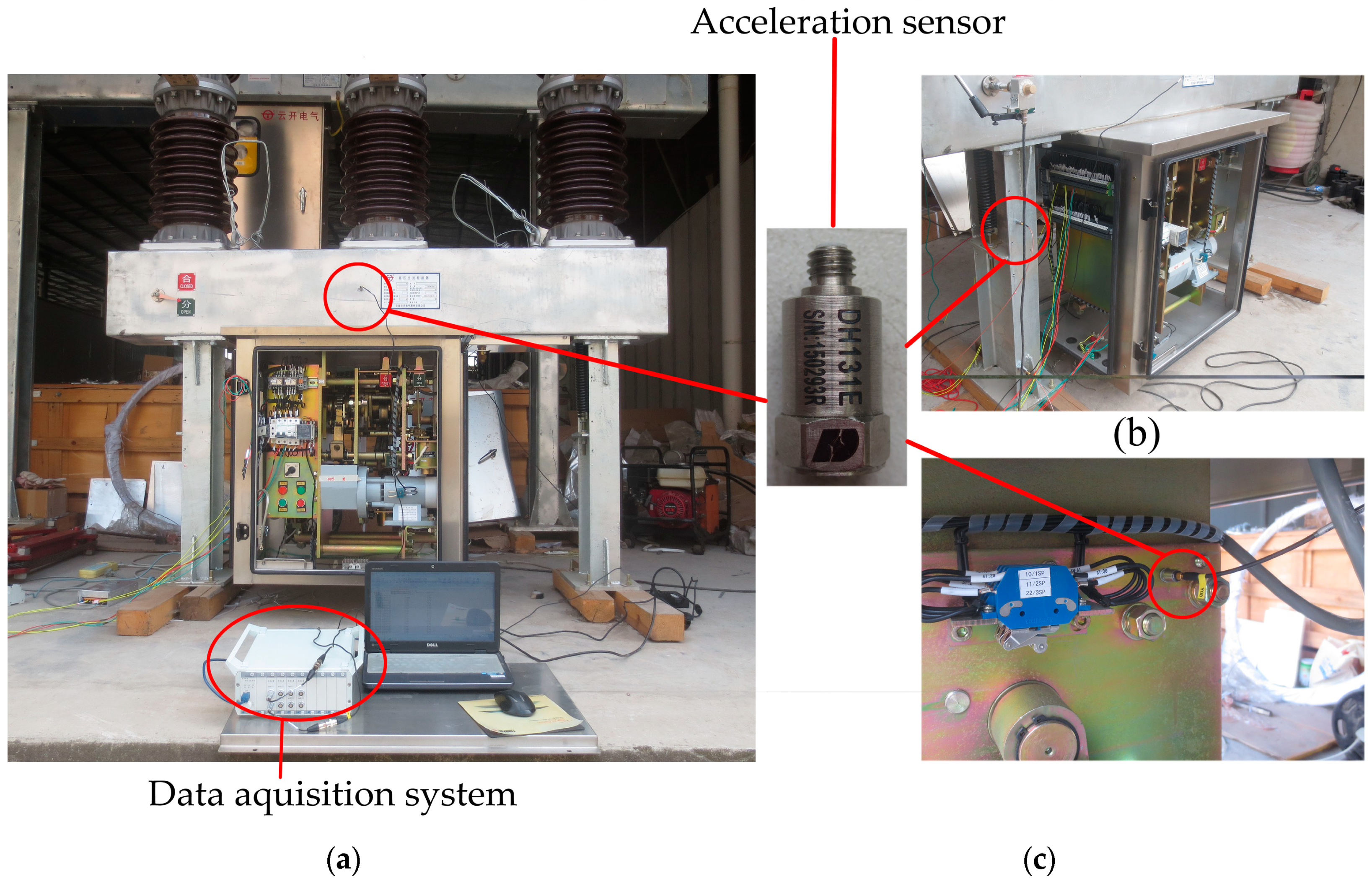

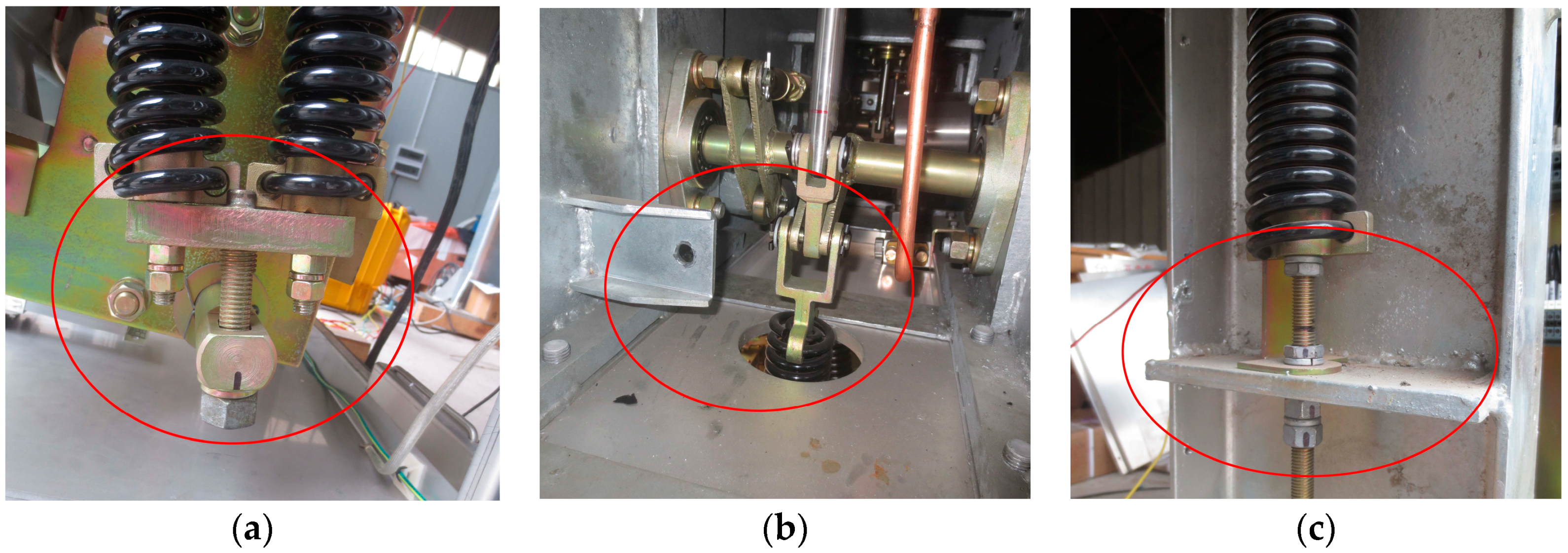
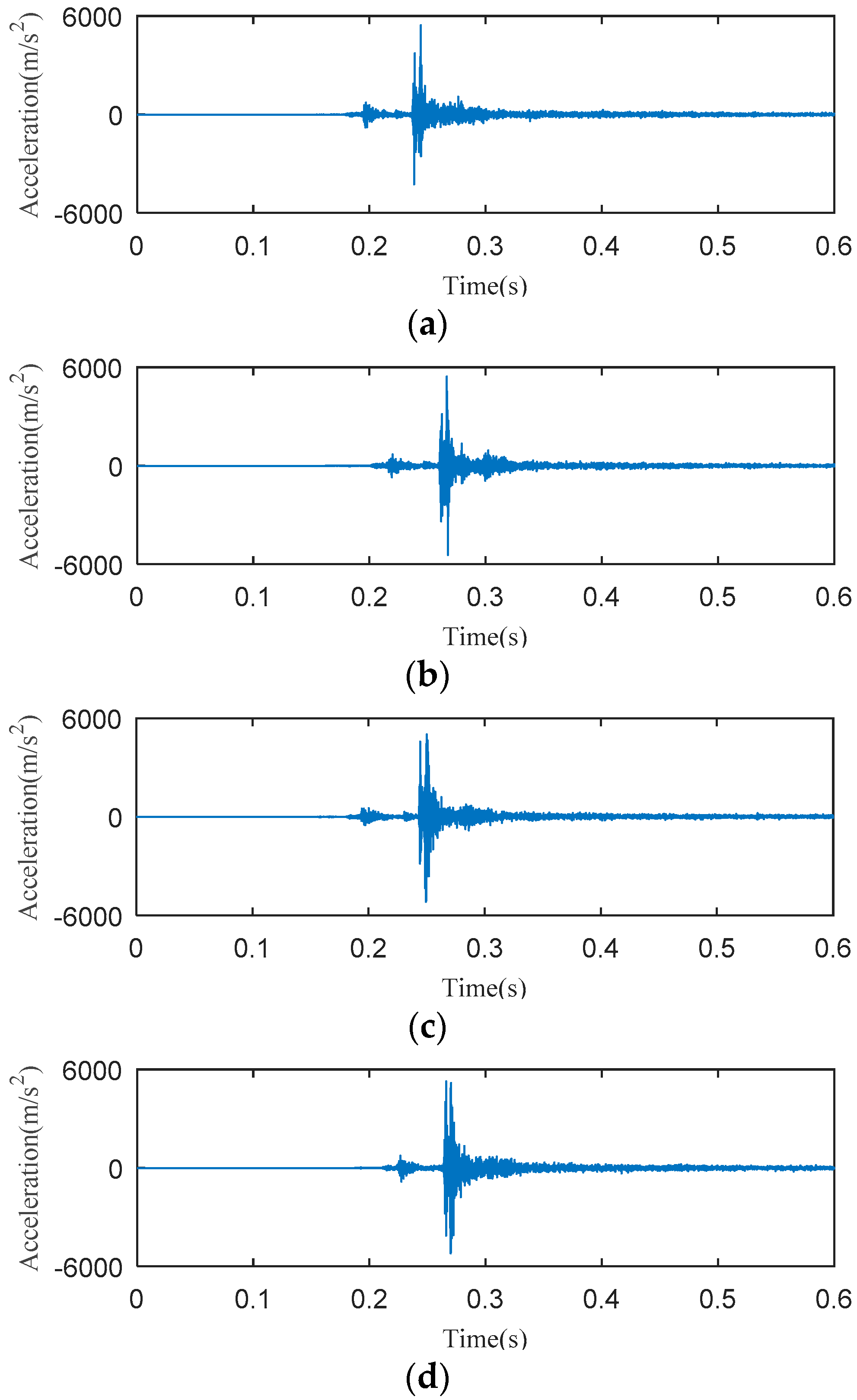
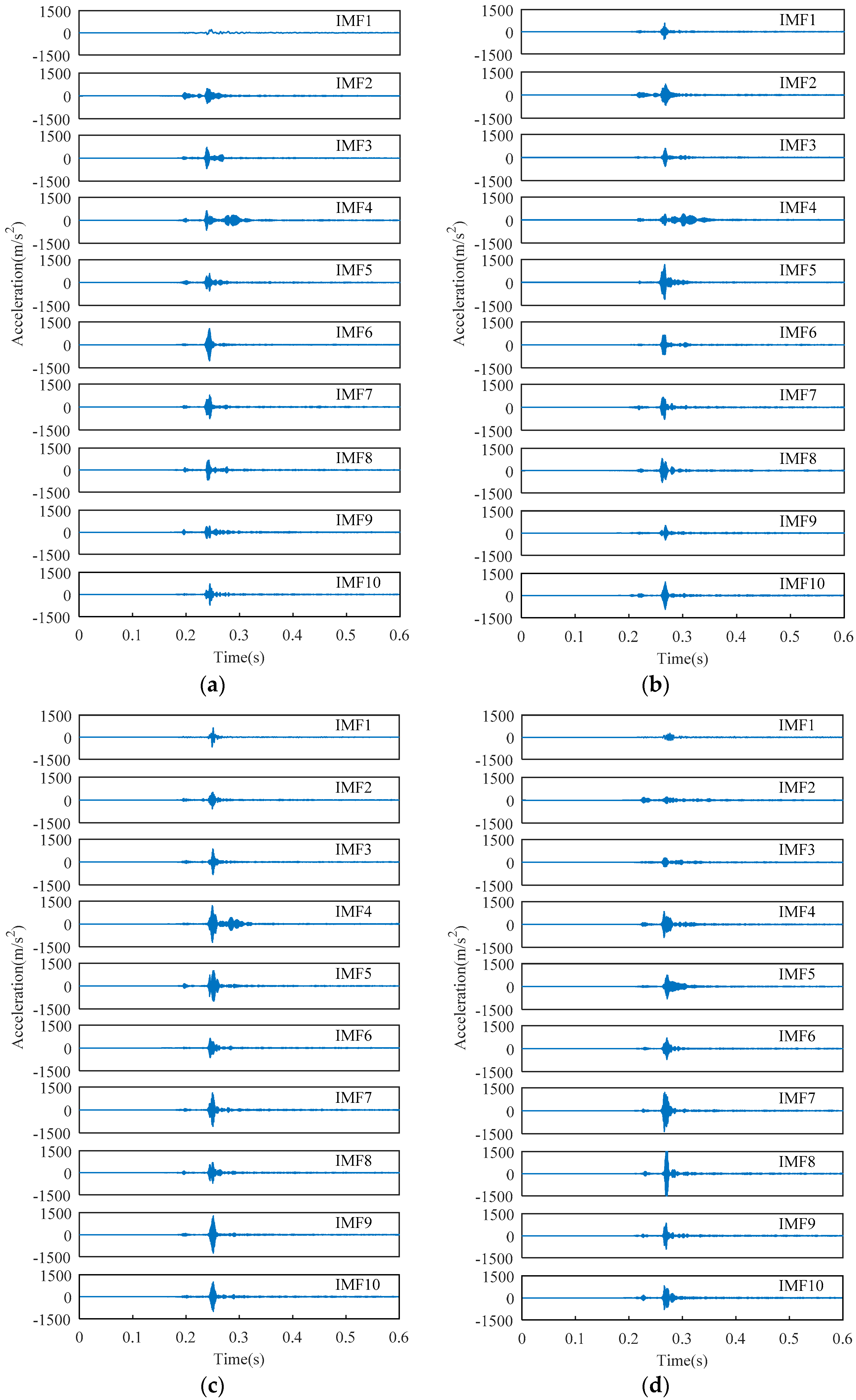
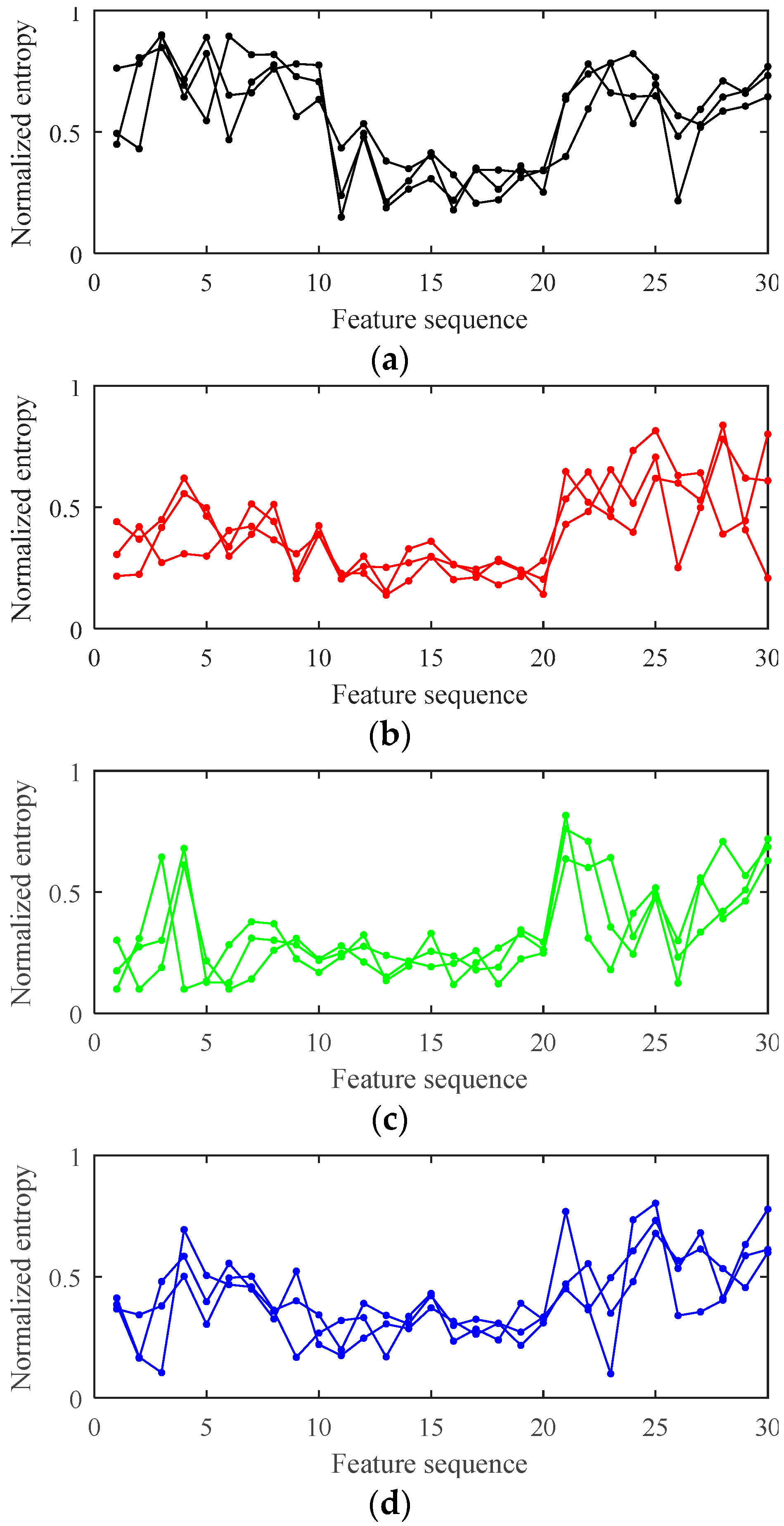
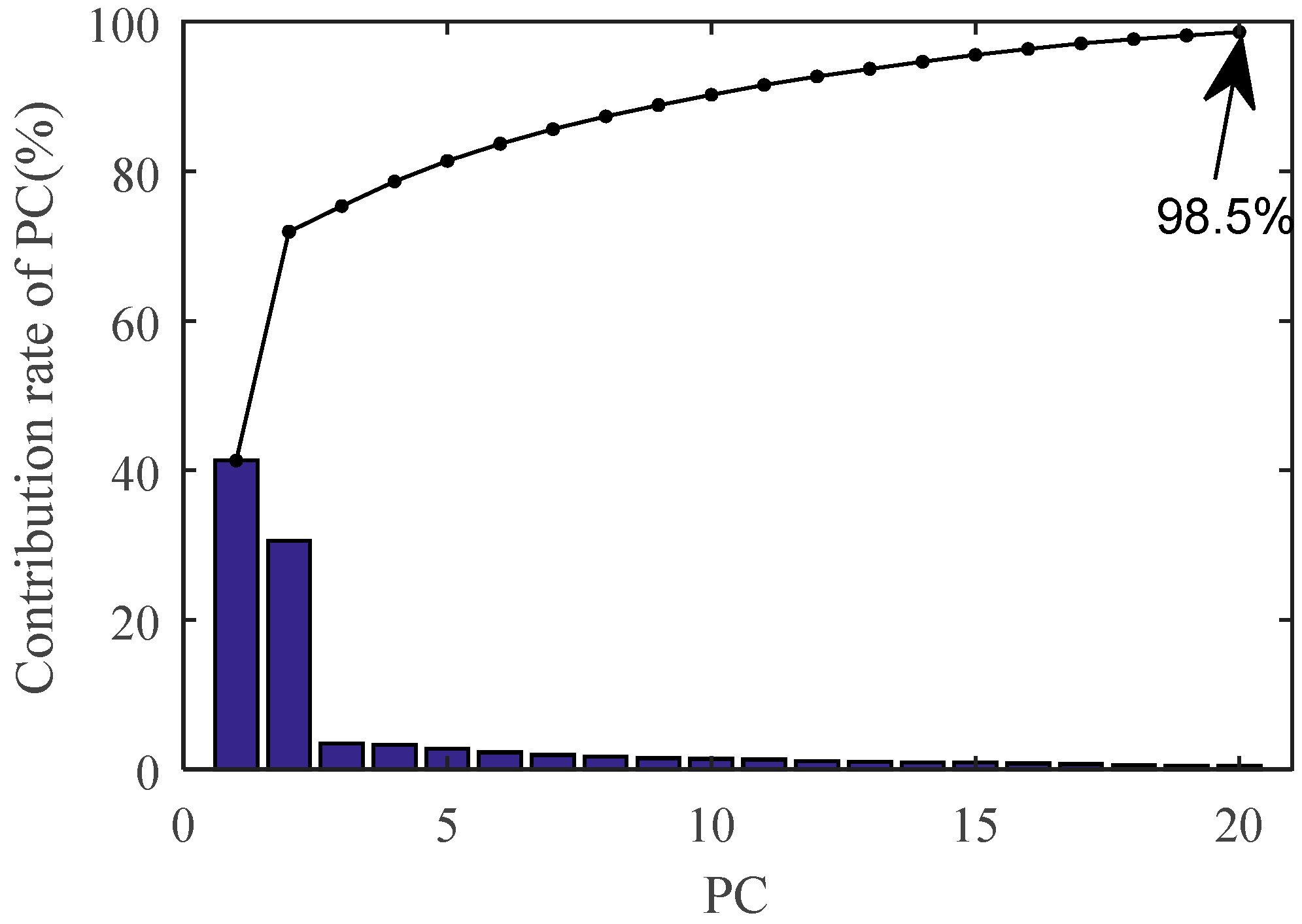
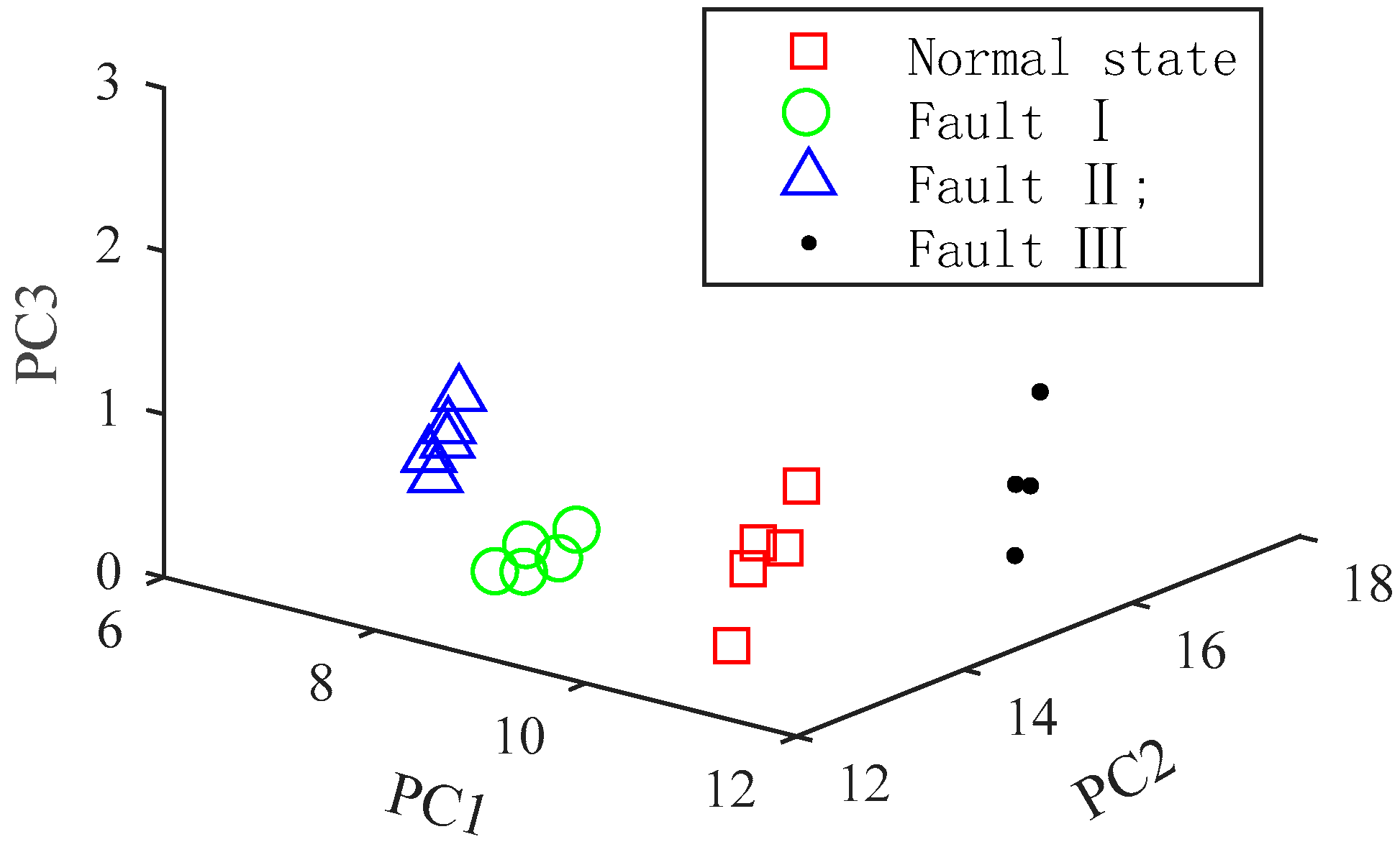
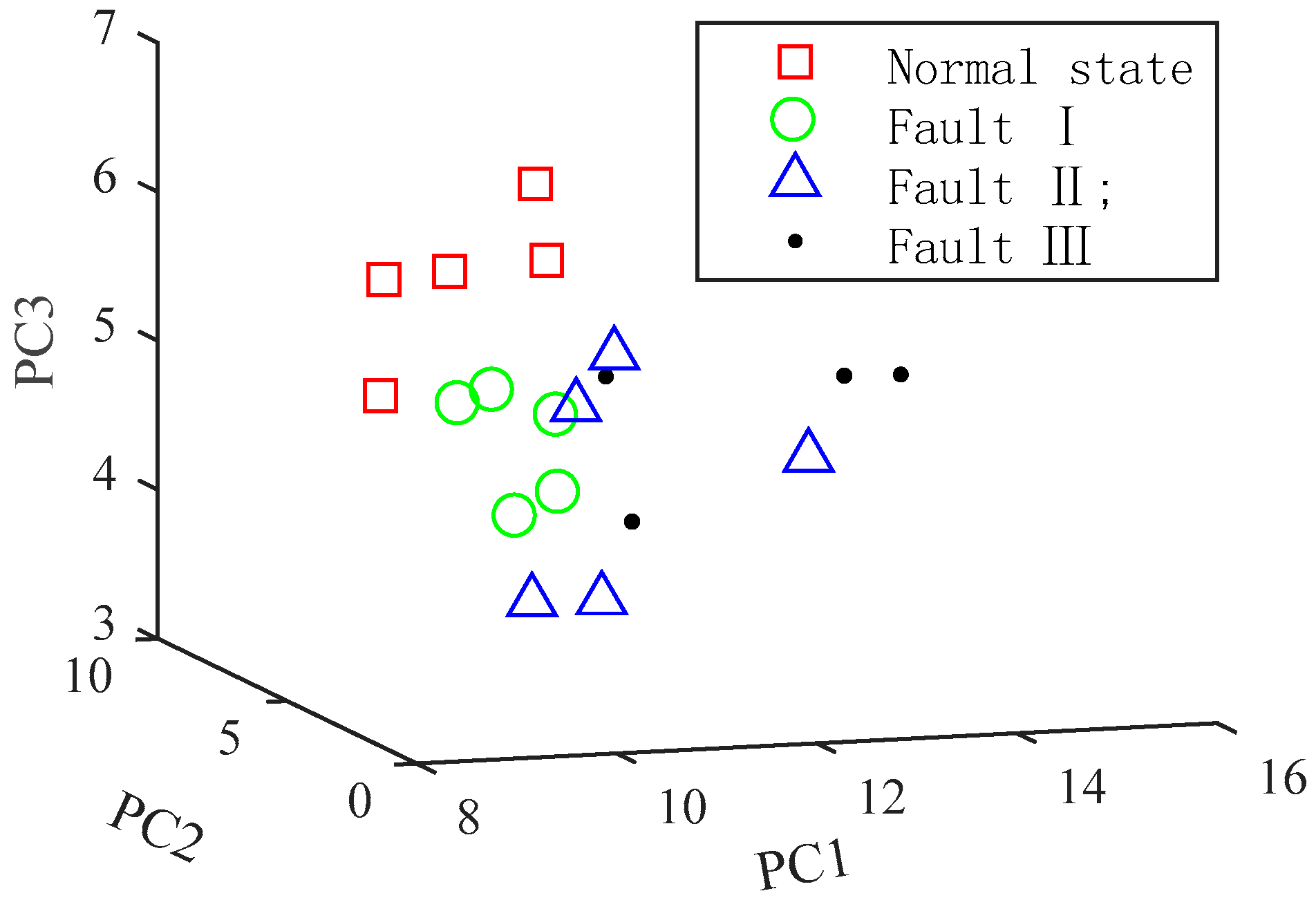
| Cases | Known States | Unknown States | Accuracy |
|---|---|---|---|
| a | 18 | 6 | 100% |
| b | 21 | 3 | 87.5% |
| c | 18 | 6 | 100% |
| Classifier | Known States | Unknown States | Accuracy |
|---|---|---|---|
| SVDD | 18 | 6 | 100% |
| SVM | 24 | 0 | 0 |
| OCSVM | 14 | 10 | 83.33% |
| Fault States | Single Feature | Multi-Feature | MFEF | |||
|---|---|---|---|---|---|---|
| CA | ACA | CA | ACA | CA | ACA | |
| Normal state | 100% | 75% | 100% | 95.83% | 100% | 100% |
| Fault I | 50% | 83.33% | 100% | |||
| Fault II | 83.33% | 100% | 100% | |||
| Fault III | 66.67% | 100% | 100% | |||
| Fault States | VMD-MFEF | EMD-MFEF | ||
|---|---|---|---|---|
| CA | ACA | CA | ACA | |
| Normal state | 100% | 100% | 83.33% | 79.17% |
| Fault I | 100% | 83.33% | ||
| Fault II | 100% | 66.67% | ||
| Fault III | 100% | 83.33% | ||
| Classifier | Normal State | Fault I | Fault III |
|---|---|---|---|
| SVM | 6 | 9 | 6 |
© 2018 by the authors. Licensee MDPI, Basel, Switzerland. This article is an open access article distributed under the terms and conditions of the Creative Commons Attribution (CC BY) license (http://creativecommons.org/licenses/by/4.0/).
Share and Cite
Wan, S.; Chen, L.; Dou, L.; Zhou, J. Mechanical Fault Diagnosis of HVCBs Based on Multi-Feature Entropy Fusion and Hybrid Classifier. Entropy 2018, 20, 847. https://doi.org/10.3390/e20110847
Wan S, Chen L, Dou L, Zhou J. Mechanical Fault Diagnosis of HVCBs Based on Multi-Feature Entropy Fusion and Hybrid Classifier. Entropy. 2018; 20(11):847. https://doi.org/10.3390/e20110847
Chicago/Turabian StyleWan, Shuting, Lei Chen, Longjiang Dou, and Jianping Zhou. 2018. "Mechanical Fault Diagnosis of HVCBs Based on Multi-Feature Entropy Fusion and Hybrid Classifier" Entropy 20, no. 11: 847. https://doi.org/10.3390/e20110847
APA StyleWan, S., Chen, L., Dou, L., & Zhou, J. (2018). Mechanical Fault Diagnosis of HVCBs Based on Multi-Feature Entropy Fusion and Hybrid Classifier. Entropy, 20(11), 847. https://doi.org/10.3390/e20110847





